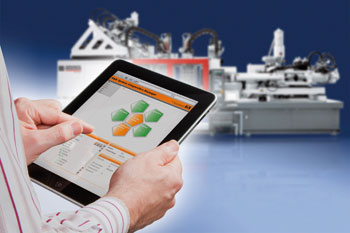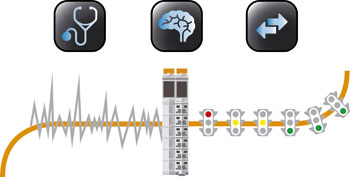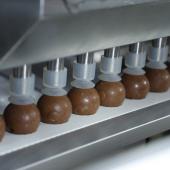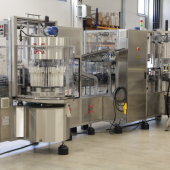Condition Monitoring
EVERYTHING IN A MODULE How to drastically contain maintenance costs and maximize productivity? B&R suggest the use of predictive strategies based on permanent condition monitoring. A function this totally integrated in its traditional control systems.
 The development efforts of mechanical engineers are paying off as the power density and functional density of production machines continue to increase. This means that fewer machines are required to produce the same quantity and complexity of products, which lowers production costs and makes machine manufacturing more competitive.
The development efforts of mechanical engineers are paying off as the power density and functional density of production machines continue to increase. This means that fewer machines are required to produce the same quantity and complexity of products, which lowers production costs and makes machine manufacturing more competitive.
On the other hand, this increased efficiency also makes producers more dependent on individual machines.
The ability to produce more units per hour means that each hour of downtime is more expensive. And anyone who has ever operated a machine knows that downtime can never be completely avoided.
Rethinking maintenance strategy
Traditional maintenance strategies have one thing in common: Those last few percentage points in machine availability come at a high price. This is true for reactive, damage-oriented maintenance, where a system's components are driven to exhaustion and only replaced when they fail. The only way to ensure machine availability in this scenario is to maintain a stock of replacement parts and have qualified personnel and the necessary equipment available on short notice. The most widespread traditional strategy, however, is preventive maintenance at fixed intervals based on experience. Although this approach has the distinct advantage of making maintenance downtime more plannable, it is certainly no cure-all and involves considerable financial risk. On the one hand, you have parts being purchased and replaced although the originals are far from the end of their useful life. On the other, you have no reliable protection against unplanned downtime, such as when asymmetric strain causes certain parts to fail prior to the maintenance interval.
Minimizing downtime as much as possible and crafting a strategic plan for maintenance that can't be avoided - these are the goals of any responsible manager who not only looks at the purchasing price when evaluating new machines, but also at the overall costs over their entire useful life. The only way to significantly impact the total cost of owner- ship is to maximize machine uptime while simultaneously minimizing maintenance costs. This is more than enough reason to rethink maintenance strategies in general.
 Interpreting data is easier (… than guessing)
Interpreting data is easier (… than guessing)
The best way to optimize the ratio of machine availability to maintenance costs is to replace the fixed maintenance intervals with condition-dependent, predictive maintenance. This involves scheduling maintenance when changes in monitored parameters indicate impending failure. The advantage of this is that components can continue to provide value until much closer to the actual end of their useful life, which is typically much later than the conservatively estimated maintenance interval. Yet there is no sacrifice in plannability since the required maintenance can be performed during regularly scheduled breaks in production. The risk of maintaining a stock of replacement parts is also minimized since only the affected components need to be replaced. This is also a way to reliably avoid failures that result from neglected maintenance.
For any of this to be possible, condition parameters throughout the ma- chine must be monitored constantly, and this data must be evaluated correctly to determine which parts require maintenance. «This can be based on simple signals and measurement values such as temperature or pressure that are collected using X20 or X67 I/O modules» explains Bernhard Eder, business manager at B&R. «On top of that, B&R also offers specialized modules such as valve control modules with integrated switching time detection or oscilloscope functions».
Countless other options for monitoring condition signals are natively integrated in B&R automation systems. These include ACOPOS servo drives with built-in motor monitoring, or example, as well as B&R Automation PCs, which are each equipped with an integrated circuit for self-diagnostics. The latest addition to this selection is a new module in the X20 series for vibration analysis.
«The sensor technology used to obtain the signals is indeed important, but the sensors alone are not enough» explains Werner Paulin. Paulin has gained years of international application experience since he joined the company in 1997 and is currently B&R's international sales manager for China. «The key to scheduling maintenance intervals for replacing components at the right time, but not too early, is correct interpretation of the recorded signals. That's the only way to accurately predict developing problems».
An optional feature becomes standard
This is why condition monitoring - which in fact has been around for decades - has been slow to take hold in traditional machine manufacturing. The complex mathematics involved have typically required large and expensive dedicated computer systems, which in turn needed to be programmed by experts in fields such as material science and oscillation mechanics. Because of this, condition monitoring was limited to systems whose failure would result in immense costs.
The shrinking scale of microelectronic components has since eliminated the need for expensive external wiring. B&R's analog input module X20AI2636, for example, comes standard with essential functions such as a comparator with hysteresis. The X20CM4810 condition monitoring module from B&R, which is currently being implemented at selected pilot customers, converts signals read from the acceleration sensors into more than 70 specific values. This allows even complex oscillation patterns to be monitored on a single channel.
Developers can easily configure which factors should be monitored in B&R Automation Studio without requiring knowledge of complex mathematical functions, which solves a lot of problems with regard to soft- ware and interfaces. At runtime, significant values are sent to the system CPU via POWERLINK and can then be used directly in the application software. «For the first time, machine manufacturers are able to offer condition monitoring not as a premium option, but as a fully integrated standard feature» states Paulin emphatically. «As a result, they can give their customers availability guarantees with considerably lower imputed risk».
Everything organized to the best
Machine operators can also benefit from the integration of condition monitoring with a company's internal logistics systems. When the machine identifies the need for maintenance, for example, it can automatically trigger a reminder to the maintenance or purchasing department for the required parts. This prevents orders from being overlooked or placed incorrectly and ensures that the right part is on hand when it is needed without having to maintain a large stock on site.
Maintenance isn't the only area where having live, pre- processed condition data opens up new possibilities, however. Recorded condition data can also be fed into the automation software to provide additional functionality. «This allows you to adjust the speed in order to extend the time before maintenance, for example, or to compensate for slack or switching delays in order to maintain optimal operating conditions» says Eder. «This kind of adaptive operation can further contribute to increased availability and a longer service life - which in the end means more efficient resource utilization and lower unit costs»




















